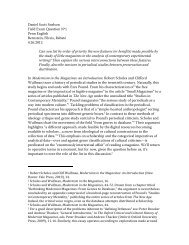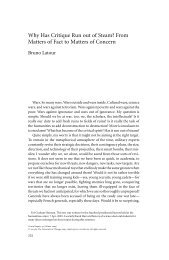The Exploit: A Theory of Networks - asounder
The Exploit: A Theory of Networks - asounder
The Exploit: A Theory of Networks - asounder
Create successful ePaper yourself
Turn your PDF publications into a flip-book with our unique Google optimized e-Paper software.
Nodes 69<br />
Places where faces shouldn’t be—can this be what swarming is?<br />
Or must one extract a “faciality” in every site <strong>of</strong> enmity? Consider<br />
an example from popular culture. In <strong>The</strong> Matrix Revolutions, there are<br />
two types <strong>of</strong> swarms, the first being the insectlike sentinels who attack<br />
the human city <strong>of</strong> Zion from all directions. In a textbook case <strong>of</strong> military<br />
swarming, they eventually defeat the humans’ defensive by amass -<br />
ing scores <strong>of</strong> individual sentinels into one large, anthropomorphic<br />
face—a literal facialization <strong>of</strong> enmity. What started as a swarm without<br />
a face becomes a face built out <strong>of</strong> the substrate <strong>of</strong> the swarm.<br />
<strong>The</strong> Matrix appears to be at once totally distributed and yet capable<br />
<strong>of</strong> a high degree <strong>of</strong> centralization (swarm versus face). While earlier<br />
science fiction films could only hint at the threatening phenomenon<br />
<strong>of</strong> swarming through individual creatures (e.g., <strong>The</strong>m!), the contemporary<br />
science fiction film, blessed with an abundant graphics technology<br />
able to animate complex swarming behaviors down to the last<br />
detail, still must put a “face” on the foe, for in the very instant the<br />
swarm reaches the pinnacle <strong>of</strong> its power, its status as a defaced enemy<br />
is reversed and the swarm is undone. (Tron does something similar:<br />
the denouement <strong>of</strong> facialization comes precisely at the cost <strong>of</strong> all the<br />
various networked avatars zipping through the beginning and middle<br />
<strong>of</strong> the film.) Again the point is not that faciality—or cohesion, or<br />
integrity, or singularity, or what have you—is the sole prerequisite<br />
for affective control or organization, for indeed the swarm has significant<br />
power even before it facializes, but that faciality is a particular<br />
instance <strong>of</strong> organization, one that the swarm may or may not coalesce<br />
around. <strong>The</strong> core ambiguity in such expressions <strong>of</strong> swarming is precisely<br />
the tension, on the macro scale, between amorphousness and<br />
coordination, or emergence and control. Does coordination come on<br />
the scene to constrain amorphousness, or does it instead derive from<br />
it? Is a minimal degree <strong>of</strong> centralized control needed to harness emergence,<br />
or is it produced from it?<br />
While the biological study <strong>of</strong> self - organization seems caught on<br />
this point, the politico - military - ethical context raises issues that are<br />
at once more concrete, more troubling, and more “abstract.” In a<br />
sense, the swarm, swarming-as-faciality, is a reminder <strong>of</strong> the defacement<br />
proper not only to distributed insects but also to distributed humans;









